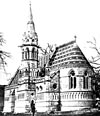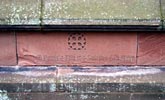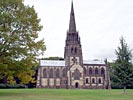For this church:    |
|
 The second The secondchapel in the 1870s |
 The 7th Duke The 7th Duke of Newcastle |
The sixth Duke of Newcastle under Lyne commissioned a replacement chapel dedicated to the Blessed Trinity, designed by T. C. Hine of Nottingham, in a severe French 13th-century Gothic style and was started to be built some 50 or so metres south-west of the present site. Whilst a great deal of the structure was erected it was never completed owing to severe financial difficulties and eventual bankruptcy of this line of the family in 1869.
 Foundation stone Foundation stone |
The third and present Chapel was begun in 1886, again a little further away from the site of the previous chapel, by Henry Pelham Archibald Douglas Pelham-Clinton, seventh Duke of Newcastle under Lyne (1864-1928). The Duke, a young nobleman pursuing at that time his first year studies at Magdalen College, Oxford, was becoming a dedicated churchman and, contrary to some earlier members of his family, was strongly affected by the Anglo-Catholic movement within the Church of England, thereby as both an act of devotion and to create a church for catholic worship, he commissioned this Chapel. Work started in 1886 when the Bishop of Southwell laid the foundation stone at low-level beneath the eastern window and the building was opened by the Bishop of Southwell on 22 October 1889.
The cost was settled at approximately £40,000.
Some of the stone from the previous chapel was reused into this latest building, which was designed by George Frederick Bodley, R.A., the senior partner of the renowned late Victorian firm of architects, Bodley & Garner.
 Chapel from Chapel from the south |
The use of the Steetley stone for much of the external facing work gave a harsh white appearance of bright steel especially when contrasted against the non-reflective rubric Runcorn sandstone of the cornices, horizontal banding and dressings; similar stone was used at Scott’s Liverpool Cathedral.
The Duke wanted to achieve a miniature cathedral of a 14th century Decorated Revival style, accented towards Anglo-Catholicism, later dedicated to St. Mary the Virgin. It will be observed when comparing the structure and some of its proportions with the cruciform church and octagonal tower of a coronet style found at St. Patrick’s, Patrington, East Yorkshire. Whilst that church is known as the Queen of Holderness, Clumber must surely be the King of the Dukeries? Its dedication, rather than consecration, was to be of major importance in later years when the finances were being hotly debated by the owners and the church authorities.
 Clumber Chapel Clumber Chapelc.1900 |
The building contractors employed, Messrs. Franklin and Sons of Oxford, took almost three years to complete the work having proceeded gradually, not only for the detail to be of a standard needed to reflect the duke’s High Church preferences, but also, to maintain a steady release of funds through the project. Perhaps this latter point was missed by Bodley when committing expenditure on several items without keeping the duke informed thus causing his own dismissal from the project.
The first service was on 22 October 1889 and among those attending was the high church Bishop of Lincoln.
The vocal music was provided by the joint choirs of Lincoln Cathedral, All Saint’s, Margaret Street, London and a local choir under Mr George F. Ashley. The start of the service was delayed, to the dismay of the estate blacksmith who had the task of hand pumping the bellows of the organ for an extended interlude owing to the house party having been delayed by a severe rain storm.
The chapel was not uncontroversial. The Rev W.K. John Kaye, the Archdeacon of Lincoln and Presbyter of the Church of England, wrote an open letter to The Times on 26 October 1889. His main point appears that the Bishop should not have allowed the choirboys to be exposed to such an extreme ritualistic service. However, most of the other letters published at the time give grateful thanks for the provision of such a magnificent chapel and for the regal celebrations.
Immediately following the celebrations, the Rev Henry T. Slodden, the vicar of Worksop’s Priory Church, became concerned that his parish finances were likely to become adversely affected by having another place of worship in the locality. He formally requested the duke to offer to the Priory Church the alms collected at the Clumber opening service, but the duke promptly rejected the suggestion, and further advised that the monies would go towards the needs of the newly-planned establishment of St Cuthbert's College at Worksop.
The 7th duke died in 1928, and the chapel fell into disuse and eventually closed when the Newcastle family home at Clumber was demolished in 1936. It reopened following the acquisition of the estate in 1946 by the National Trust. Visitors were allowed to gain access to parts of the building, and services were resumed at set intervals.
 Lamp by Lamp byRev E Geldert |
The Rev Ernest Geldart was responsible for the wrought iron and copper oil lamps, with opalescent shades, which hang over the choir stalls. These were partly made by the blacksmiths from the estate village of Hardwick and are a fitting tribute to their skills and ability.
When the first electricity supply system was installed at Clumber House in 1906 this was extended although on a very limited load basis to include lights in the stable-yard, Parsonage and Chapel vestry. The supervision of the installation was undertaken by W.H. Massey of Twyford, Berkshire.
The system emanated from a generation unit powered by a patented gas suction plant, with an Anthracite coal fuelled gas producer and twin gas engines as manufactured by Messrs. Crossley of Openshaw in Manchester.
The electrical supply was enhanced in 1933 when the mains cabling was extended into the estate from the local colliery generation plant network for general lighting and power use. Some of the Estate families raised £41.10s towards the cost of extending illumination into the body of the Chapel, thus allowing internal floodlights to be fitted. Lord Lincoln also proposed and was accepted by the then owner, the London and Fort George Land Company, that the exterior of the Chapel should be lit by hidden floodlights.






